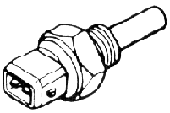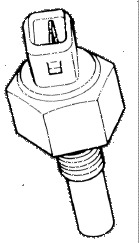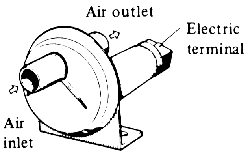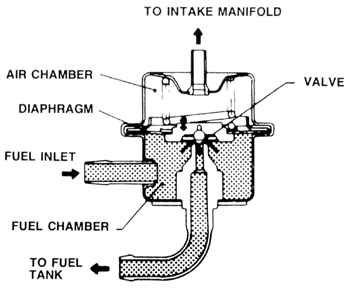FuelInjectionTheory: Difference between revisions
No edit summary |
No edit summary |
||
| Line 37: | Line 37: | ||
The cold start valve is actually an additional injector solenoid, usually mounted in the intake manifold. The cold start valve is energized through the starting system and the thermo-time switch, spraying extra fuel into the manifold while the starter is turning the engine over. To prevent excessive fuel from being injected into the engine during starting, a thermo-time switch is incorporated in the circuit. | The cold start valve is actually an additional injector solenoid, usually mounted in the intake manifold. The cold start valve is energized through the starting system and the thermo-time switch, spraying extra fuel into the manifold while the starter is turning the engine over. To prevent excessive fuel from being injected into the engine during starting, a thermo-time switch is incorporated in the circuit. | ||
=== Auxiliary Air Valve === | |||
The auxiliary air valve acts as the choke for the fuel injection system. When the engine is cold, it bypasses extra air around the throttle plate, which is read as extra air flow by the ECU, which signals for additional fuel. While it is opened there will be an increase in RPM's. A bimetallic strip, activated by the temp of the housing, and an electrical heater coil, to prevent excessive operation of the auxiliary air valve, control a rotating disc inside the chamber. The disc has a hole in it , and when, the hole lines up with the matching hole in the chamber, extra air is inducted into the engine. This bit bypasses the throttle plate. As the bimetallic strip heats up, it rotates the disc, gradually closing off the hole until all the air is passing into the engine through the main throttle passage. | The auxiliary air valve acts as the choke for the fuel injection system. When the engine is cold, it bypasses extra air around the throttle plate, which is read as extra air flow by the ECU, which signals for additional fuel. While it is opened there will be an increase in RPM's. A bimetallic strip, activated by the temp of the housing, and an electrical heater coil, to prevent excessive operation of the auxiliary air valve, control a rotating disc inside the chamber. The disc has a hole in it , and when, the hole lines up with the matching hole in the chamber, extra air is inducted into the engine. This bit bypasses the throttle plate. As the bimetallic strip heats up, it rotates the disc, gradually closing off the hole until all the air is passing into the engine through the main throttle passage. | ||
Revision as of 12:59, 1 September 2009
Bosch L-Jetronic Fuel Injection
Intro
The system is of the timed port-injection type, with injection solenoids delivering the fuel on demand, the length of time the solenoid is open determining the amount of fuel being delivered to the engine. The time the injector is held open, and therefore the amount of fuel that is delivered into the engine, is determined by the Electronic Control Unit (ECU), which receives signals from a variety of sensors, the key of which is the air flow meter, which measures the amount of air entering the intake system.

Air Flow meter
Installed above the air filter box on the L-Jetronic system is a movable flap connected to a potentiometer which measures the amount of air being inducted into the system. The more air entering the system, the farther the flap is forced open. At the same time the signal is being sent by the air flow meter, other signals are coming to the ECU from the throttle position switch and the air temperature sensor. All of these signals are integrated by the ECU to to determine how long the injectors should be held open. In addition to the flap of the air flow meter, there is a small bypass port which controls idle speed by increasing(or decreasing) the amount of air which passes through the air flow meter at idle. Because the measurement of the amount of air flowing into the engine is the primary determinant of the amount of fuel injected, it is critical that only air passing through the flow meter be allowed into the engine. Any leaks in the system will not be accounted for by the air flow meter, which can cause the engine to run lean (or not run at all).
Throttle Position Switch
The throttle position switch is mounted on the front side of the throttle body, where it signals idle and full throttle conditions to the ECU. The ECU, when it receives a full throttle or idle signal fron the TPS, adjusts the fuel/air mixture for these operating conditions. When the throttle is in the idle position, the TPS signals the ECU that idle enrichment is needed. The TPS also cancels the input to the oxygen sensor during coast-down to keep the system from being affected by excessive oxygen at that time.
Electronic Control Unit
ECU The electronic control unit(ECU) is the heart of the fuel injection system. It receives signals from various sensors and uses these signals to determine the amount of fuel needed at any given moment. There are different operating paramaters for the fuel injection system for particular vehicles and because of this the ECU can not be interchanged between different models. The ecu is a solid state device(no moving parts). When an ECU fails it is almost invariably because something outside that unit has failed, interfering with the signals into or out of the ECU. In this case, it is commom for the ECU to self-destruct, and since it is an expensive piece of equipment, it is advisable to exercise extreme caution when working with any components connected to the ECU. The two key precautions to take when working with the ECU connected components are: 1) never disconnect the ecu with the ignition switch in the ON position, and 2) always take extreme care with connectors to make sure that connecting pins enter only the correct receptacles.
Coolant temperature sensor
When the engine is cold, additional fuel is required, and, just as the choke on a carburetor enriches the mixture by reducing the amount of air taken into the engine, the coolant temperature sensor signals the ECU to hold the injectors open longer when the engine is cold, passing more fuel into the engine.

The temperature sensor is inserted into the cooling system, much like the coolant temperature probe which activates the temperature guage or warning light. The coolant temperature sensor on Fiats is installed where the coolant enters the cylinder head. As the coolant warms the extra enrichment is reduced, until the engine is at normal operating temperature. The sensor is actually a thermo-resistor, where it's resistance decreases as it gets warmer.
Thermo-Time switch
The Thermo-Time switch regulates the amount of time the cold start valve is energized and prevents the opening of the cold start valve when the engine is warm. It is located on the underside of the intake manifold. The "thermo" section of the switch is a heater coil. When the starter is energized, current is passed through the thermo-time switch and into the cold start valve. As the current passes through the switch, a heater coil warms a bimetallic switch. It takes between 8 and 12 seconds for the heater coil to warm up to the point that it opens the circuit, preventing further fuel from passing through the cold start valve. (An important point to remember when troubleshooting starting problems with the cold start valve) The length of time the circuit is energised (8-12 sec) is controlled by the coolant temperature, the longer it will take the heater coil to warm the bimetallic switch.

Cold start valve
The cold start valve is actually an additional injector solenoid, usually mounted in the intake manifold. The cold start valve is energized through the starting system and the thermo-time switch, spraying extra fuel into the manifold while the starter is turning the engine over. To prevent excessive fuel from being injected into the engine during starting, a thermo-time switch is incorporated in the circuit.
Auxiliary Air Valve
The auxiliary air valve acts as the choke for the fuel injection system. When the engine is cold, it bypasses extra air around the throttle plate, which is read as extra air flow by the ECU, which signals for additional fuel. While it is opened there will be an increase in RPM's. A bimetallic strip, activated by the temp of the housing, and an electrical heater coil, to prevent excessive operation of the auxiliary air valve, control a rotating disc inside the chamber. The disc has a hole in it , and when, the hole lines up with the matching hole in the chamber, extra air is inducted into the engine. This bit bypasses the throttle plate. As the bimetallic strip heats up, it rotates the disc, gradually closing off the hole until all the air is passing into the engine through the main throttle passage.

Injector
The fuel injector is an electrical solenoid, controlled by the ECU. Fuel under pressure is supplied to the injector, and a pressure differential of about 36 psi is maintained between the fuel line pressure on one side of the injector and the manifold air pressure on the other side. Inside the injector is a coil. When current is supplied to the coil the injector valve opens, allowing fuel to pass through the unit and into the intake manifold. The ECU controls the current reaching the injector. The longer the ECU sends an "open" signal, the more fuel is injected into the engine. Although there is one injector per cylinder mounted in the intake manifold just upstream from each intake valve, all the injectors receive the signal from the ECU at the same time, so the actual injection of fuel into the passage is independent of the position of the piston (on intake stroke, exhaust stroke, etc) at the time of injection. When the intake valve opens, the fuel has already been injected into the port and is ready to be drawn into the cylinder. With the intake valve opening to draw fuel some 30 times per second or more at cruising speed the fact that the fuel is not injected at exactly the moment that the intake valve opens is unimportant. (although in my mind it raises some questions about efficency)
Fuel Pressure Regulator
A key component of the system is the fuel pressure regulator, which works with the fuel pump to maintain a steady pressure relationship between the fuel line side of the injectors and the intake manifold. It is located mounted to the fuel rail (fuel manifold).

Since the fuel is metered by the ECU by altering the amount of time the injector is held open, the volume of fuel injected would vary if there was a pressure difference between fuel supply and the intake manifold under different conditions. When there is a high vacuum in the intake manifold, such as at high rpm, the pressure in the fuel system must be reduced. When there is low pressure in the intake manifold, such as at low speed or full throttle operation, the pressure in the fuel line must be increased. The essential requirement is that the pressure differential remains the same under all circumstances, so that only the time the injector is open determines the amount of fuel injected. In order to maintain desired fuel pressure, excess fuel is returned to the tank by a separate line from the pressure regulator.
Taken from: http://www.abarth-racing.dk/bosch.php